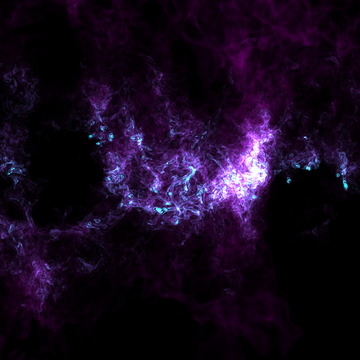Cosmology and High-Energy Astrophysics

Created in the past 13.8 billion years since the Big Bang, the “cosmic web” originated from an originally almost homogeneous medium. The enormous network of filaments spans cosmic voids in our universe. Galaxies emerged in the dense regions of cosmic filaments while enormous galaxy cluster formed at the knots of the “cosmic web”. Cosmology is concerned with understanding physical processes that lead to the emergence of cosmological structures and which shape their continuous development. On the one hand, observations of the local universe are being used to narrow down cosmological models. On the other hand, cosmologists test their theories through computer simulations. They use them to simulate the origin and evolution of cosmic structures – from the first galaxies and the intergalactic medium to the populations of galaxies and clusters of galaxies and the large-scale structure of the universe itself.
In this way, we gain insight into structural growth caused by attractive effect of gravity and learn how magneto-hydrodynamic processes in gas lead to the formation of stars and supermassive black holes. The dynamic and thermal effects of these objects on the properties of the cosmic gas, known as feedback, also play an important role. In particular, we examine how cosmic rays, ultra-violet radiation from young, massive stars and energy deposition by exploding supernovae feed back on the ambient plasma and modulates star formation in the galaxy. The complex computer simulations are calculated and evaluated on European supercomputers and the computer clusters at AIP.

Cosmography is the art of charting the cosmos. Seen here is a “quasi-linear” map of the universe, with the Earth at the centre of the three arrows. The main clusters of superclusters are shown deep inside dense (red) regions.
Credit: Hoffman et al. 2018Our research programme is wide-ranging and investigates the formation and development of cosmological structures. This ranges from the formation of the first galaxies reionizing the universe, to the properties of the intergalactic medium, to the current population of galaxies and galaxy clusters. These cosmological studies are complemented by small-scale plasma-physical simulations, which have the task of discovering the origin of cosmic rays by particle acceleration at shock waves. Furthermore, we investigate the propagation of cosmic rays in galaxies and galaxy clusters and how forces and energy are transferred to the surrounding thermal plasma. This enables us to model high-energy, astrophysical processes in galaxies and galaxy clusters which make them glow at radio wavelengths up to gamma rays.
In our section, we tackle these challenging problems by innovatively combining theory, simulations and observations. In doing so, we combine "paper-and-pencil" theory with an advanced simulation technique realised in the Arepo code. This cosmological magneto-hydrodynamic code uses a moving grid as the underlying numerical structure and enables simulations with unprecedented accuracy, numerical resolution and physical completeness. For kinetic plasma simulations, we also use highly accurate numerical techniques realised in the SHARP code, and study plasma instabilities and the transport of cosmic rays.
The Cosmography and Large-Scale Structure group participates in the Cosmic-Flows sky survey project to observe our cosmological environment up until distances of roughly half a billion lightyears. To create the most detailed maps of the local universe, they married numerical simulations with observations using advanced algorithms.
Satellite galaxies have been found to orbit the Milky Way in a puzzling plane similar to the planets orbiting our Sun. Recent observations with the Gaia and Hubble space telescopes have made it possible to measure the full three-dimensional motion of these galaxies and to test different theories of their origin as well as our cosmological standard model.